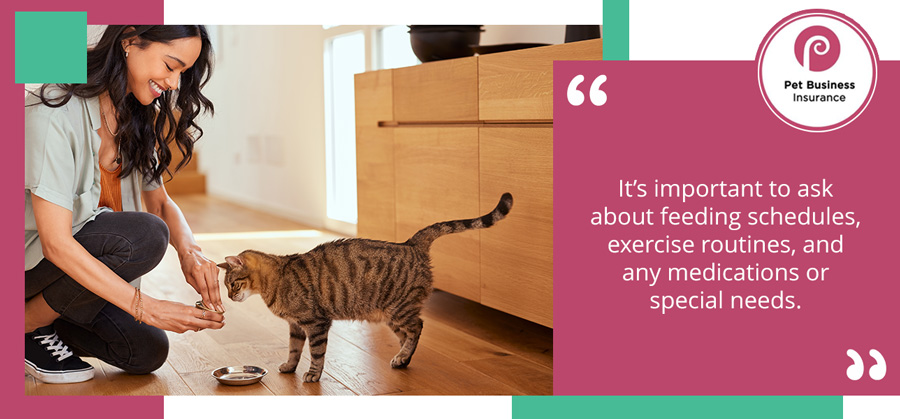
If you’re looking at starting your pet sitting business, then it’s only practical that you get to know what to include in your pet sitting contract. Pet sitting, dog walking, and other pet service businesses are a relatively new profession that’s gaining immense popularity in the US and across the world.
The number of US households owning a pet has increased in recent years from 136 million in 2019 to 145 million in 2023. A recent report shows that pet owner spending on pet related products and services has reached an all-time high of around 136 billion U.S. dollars in 2022.
This highlights the heightened demand for pet services. Many pet owners go on vacation every year without their animals and will require pet sitting, boarding and dog walking services. So, let’s look at what you need to include in your pet sitting contracts.

Who Is a Pet Sitter?
A pet sitter is a contracted service provider whose primary role involves taking care of other people’s animals in their homes while their owners are away. In most cases, pet sitters typically visit and check on the owner’s pet from 30 minutes to an hour at a time. However, the length of the visit may vary depending on the pet’s needs, pet sitter’s contract (also known as services agreement), and the mutual agreement between the owner and pet sitter.
What Does a Pet Sitter Typically Do?
Pet owners count on pet sitters to perform a couple of roles to ensure their pets receive the care and attention they deserve while they’re away. Pet sitters are responsible for feeding the animals, giving them water, as well as any medication they may need. They can also play with the pets and clean up their litter or cages. Additionally, some dog and cat sitting services also offer extras like grooming and walking.
These services may vary depending on what you have laid out in your pet sitting contract. That means that as a pet sitting business owner, you may adjust services to fit your schedule and availability. Your pet sitting contract should clearly outline the services provided, limitations, and any other information regarding the client’s animal and home-care needs.

What Should I Include in My Pet Sitting Contract?
Having a pet sitting contract is the first step to setting up your business. This is a vital legal document which, when combined with your pet sitter insurance, sets you off the hook against any liability claims. If you offer additional services such as pet boarding and dog walking, ensure that these services are covered by your insurance policy and follow any licensing requirements. Your contract has to adhere to your local and state laws and should be reviewed by a legal advisor to ensure it complies with the legal requirements within your jurisdiction.
As your best defense against possible legal claims, your pet sitting contract should include the following key items:
Services Description & Frequency of Visits
Make sure your pet sitting contract clearly outlines the services you offer and the number of visits you make per day. Pet feeding, dog walks, and playing are some of the services you can include in your contract. You can include more or fewer services depending on your flexibility and level of experience. Note that more services translate to higher pay.
Terms & Modes of Payment
Your client reserves the right to know your prices and payment modes. In this regard, your pet sitting contract should outline your terms of payment information. Your terms of payment should specify whether the client should pay a deposit while booking, complete the payment at the first visit, or be billed the full amount when they return. Additionally, be sure to provide your preferred mode of payment, whether it’s cash, check, or credit card only.

Pet Care Routine
It's important for them to ask owners about their pet's routines to provide the best care possible. Asking questions about feeding schedules, exercise routines, and any medications or special needs ensures that you maintain consistency and follow the pet's established routine. Ask them about their pet’s favorite hiding places and any special toys they may like.
It's also helpful to inquire about any particular likes or dislikes the pet may have, as well as any specific behaviors or commands that the owner uses. By gathering this information, you can create a comfortable and familiar environment for the animal, making their time away from their owners as stress-free as possible. Remember, open communication is key in ensuring that your client’s furry friend receives the best care while they’re away!
Home Care Guidelines
Figure out the pet owner’s home rules prior to their departure. Home care guidelines have to do with what is allowed and what is not allowed. For instance, at what specific temperature should the thermostat be set while they’re away? Is a pet sitter allowed to use their restroom during their daily visit routines? Is it okay to use the home tools and appliances, including refrigerators and Wi-Fi, while the homeowner is away? Make sure you’re accustomed to the keys and alarm codes information before your client departs for their vacation.
Pet Behavior & Medical History
Make sure you understand the pet’s behavior and medical history. How does the pet’s temperament look like? Are they shy around strangers? What about their health conditions? Is the pet under any medication? Be sure to gather all these details to ensure you take care of the pet properly and meet your client’s expectations.
Client’s Contact Details
It’s important to be able to contact the client while they’re away; especially if there’s something they need to know. You should therefore collect your client’s contact information. It's also essential to know emergency contact information and the nearest veterinary clinic in case of any unforeseen situations. This can include nearby family members or friends. By gathering all this information, you can provide peace of mind to both the owners and their beloved pets while in your care.
There are many other things to include in your pet sitting contract, and the above factors are just some of the key things that shouldn’t miss out on in any given pet sitting contract. Since every pet sitting service is unique, you need to customize your policies and procedures to address the specific services that your business offers. Finally, ensure that your contract has space where your client can append their signature to make it a binding agreement!